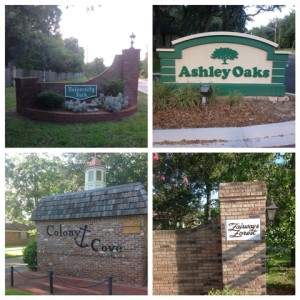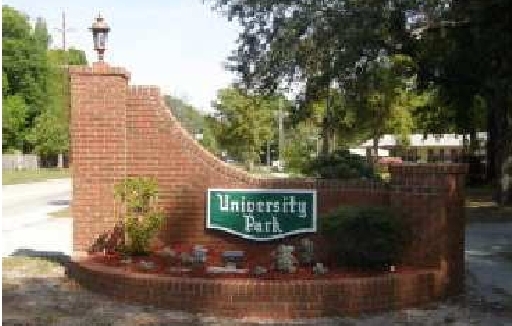Neighborhoods
Clifton, Charter Point, Lake Lucina, University Park, Oakwood Villas, Ashley Oaks, Alderman Park. These are just a few of the neighborhoods that make up the community of Arlington. Settling the banks of the St John’s River, Arlington grew East and South creating small clusters of homes. Over the years these clusters of homes became neighborhoods. Some neighborhoods have come and gone. Some neighborhoods have been in-place for years and some are relatively new.


With so many neighborhoods build over many years, in Arlington you can pick your neighborhood based on the style of home you like the most. The neighborhoods are also varied in landscaping options from zero lot-lines, to estate size properties. Your options are virtually limitless in Arlington.
One community, many neighborhoods.
We are Arlington!
Monterey
Monterey is the area of Arlington bounded by the St Johns River (west), Arlington Road (north), University Blvd. (east) and the Arlington Expressway(south). It occupies a large part of the northwest quadrant of the University Blvd/Arlington Expressway intersection, with its development likewise spawned by the opening of the Mathews Bridge in 1953.
Prior to the bridge’s construction, several historic communities were established in the area. Arlington Road was the main east-west road, and its western terminus at the St. Johns River was the landing for the ferry that shuttled passengers from Arlington to downtown Jacksonville until the 1930s. Maritime and other uses were also established in the area including the Arlington Post Office, originally housed in its own building on the hillside of the southwest corner of Arlington Road and River Bluff Road. After ferry service was discontinued, the town center migrated to the Cross-roads – the intersection of Chaseville Road (University Blvd) & Arlington Road, where it developed into Arlington’s first commercial district in the mid 1900s.
Monterey’s development evolved with a mix of uses that included banks, strip retail, office space, single family homes and multi-family apartments. It also included Riverton Towers, home to Jones College’s main campus.
Monterey’s residential subdivision includes more than 200 homes, largely built in the late 1950s to early 1960s. Though most are modest ranch homes, its riverfront is dominated by a number of custom built residences, grand specimens of Jacksonville’s mid-century modern architect built after the Mathews Bridge first opened, and Arlington – and Monterey – were the blank canvas upon which Jacksonville’s most prominent architects painted their residential masterpieces.
University Park
University Park is the home to Jacksonville’s largest park, the 120 acre Blue Cypress Park and Golf Course, Indian burial grounds, and the historic St. Isabel Plantation. Today the boundaries of the community are the St. Johns River on the west, Ft. Caroline Road on the south and a wandering St. Isabel Drive on the east and north. Large waterfront homes and smaller ranch style homes can the found through out this community, which is very convenient to downtown Jacksonville and the Beaches.

The community had several periods of development from the mid 1950s through the early 1970s. With growth covering nearly twenty years, homes of many shapes and sizes can be found throughout the neighborhood of nearly five hundred homes. Many of its homes have large oak trees which are much loved for their beauty and cursed during times of hurricanes, and intense northeasters.
University Park is a blend of retired residents who are the original owners of their homes as well as many first time homeowners who are looking for an established neighborhood, with homes that were built to last.
University Park Civic Association (UPCA) has been an active association for most of the history of the community. In recent years, UPCA has leveraged technology, www.universityparkjax.com, and “people on the street” to establish a Neighborhood Watch program and a strong sense of community.
University Park remains a great place to raise your family.
Alderman Park
The neighborhood known as Alderman Park was developed beginning in early 1955 by W. C. Whelan, who purchased the property from Carlotta Townsend Alderman. This area, located north of the Arlington Expressway and east of Tree Hill Nature Preserve, would see a building boom that spanned from the mid-50s, through the 1960s and into the early 70s, eventually result ing in the 815 mostly brick and block homes of today.
Advertisements touted Alderman Park as “The Correct Address” with a “Galaxy of Heavenly Homes,” both contemporary and conventional, and cited the convenience to both the beach and town – with no traffic congestion!
Homes were designed by renowned architects including Robert C. Broward and George Fisher, to other architects whose names are unknown to us today. At the 1957 Parade of Homes, 17 builders were represented, and the Florida Times Union reported that “. . . some of the homes are quite elaborate; others are designed to be well within the financial reach of a large portion of the population.”
Even though almost sixty years have passed, home buyers still seek the convenience of Alderman Park, the solidly constructed homes, and the active community. Alderman Park Civic Association, formed in 1958 because of concern over a dangerous intersection at Townsend Blvd. and the Arlington Expressway, is recognized as the longest continuous civic association in Jacksonville. Among other activities are a Welcome Neighbor program, Neighborhood Watch, Yard of the Month contest, neighborhood-wide garage sales, a quarterly newsletter, directory and Christmas luminaries.
Fort Caroline Club Estates
Fort Caroline Club Estates is one of Arlington’s largest subdivision neighborhoods, emanating from the intersection of Ft Caroline and Rogero Rds. northward to the St. Johns River, and to Lencyzk Drive on the south.

Fort Caroline Club Estates was developed by Lonnie Wurn and the Wurn Arlington Construction Company beginning in 1958, and was a prime development in Arlington’s first years after the opening of the Mathews Bridge. The development featured a full sized recreation building, swimming pool, tennis courts and a play area all in a spectacular riverfront setting. The amenities were sold in 1962 to the neighborhood association, Fort Caroline Club, Inc. Excluding the recreation building (clubhouse), the Club signed an agreement with the City in 1984 allowing use of the other recreation facilities by the general public, and then sold all of the property to the City in 2001. The clubhouse and pool are still integral parts of the neighborhood and are a source of great neighborhood pride.
Homes in Ft. Caroline Club Estates range from small ranch houses to riverfront mansions. Some prominent examples of mid-century modern architecture can be found, including the 1959 Parade of Homes’ featured site, Geodesica, one of only eight known such houses in the U. S.
The Fort Caroline Club Estates neighborhood is a vibrant part of the Arlington community and has been active in civic affairs for almost fifty years.
